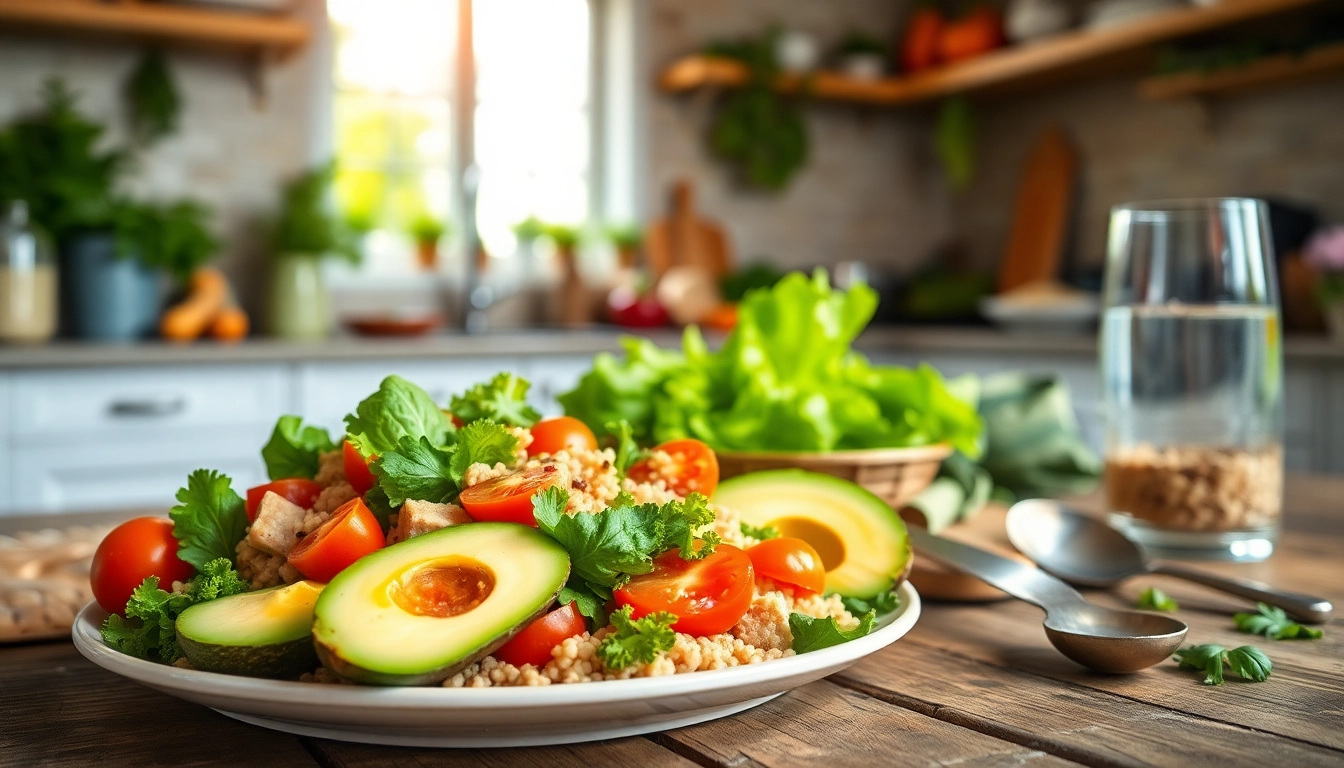Understanding Healthy Meals for Weight Loss
Embarking on a weight loss journey can often feel daunting, filled with conflicting information and a wide array of fad diets. However, at the core of effective weight loss lies the understanding of what constitutes a healthy meal to lose weight. Healthy meals should not only support weight loss but also provide the necessary nutrients for overall well-being.
What Constitutes a Healthy Meal to Lose Weight
A healthy meal for weight loss is typically calorically balanced, rich in nutrients, and composed of whole foods. These meals should include a variety of food groups, ensuring that your body receives all the essential nutrients. Key components of a healthy meal include:
- Lean Proteins: Excellent for muscle repair and growth, they also help you feel fuller for longer.
- Whole Grains: Such as brown rice or quinoa, offer essential fiber and energy.
- Fruits and Vegetables: These are packed with vitamins, minerals, and antioxidants.
- Healthy Fats: Sources like avocados and nuts support nutrient absorption.
The Science Behind Meal Composition
The composition of a meal plays a crucial role in how it affects weight loss. A well-balanced meal typically features the right ratios of macronutrients (protein, fats, and carbohydrates). The following principles are vital to understand:
- Protein: Increases satiety and helps maintain muscle mass during weight loss.
- Fiber: Aids digestion and prolongs the feeling of fullness, which is essential for weight management.
- Complex Carbohydrates: Provide sustained energy while controlling blood sugar spikes.
- Healthy Fats: Essential for hormone regulation and improving nutrient absorption.
Common Misconceptions About Weight Loss Meals
Many misconceptions surround the idea of weight loss meals. Common myths include:
- All fats are bad: On the contrary, healthy fats are critical for overall health.
- Carbs must be eliminated: Instead, focus on the quality and type of carbohydrates.
- Skipping meals aids weight loss: This often leads to binge eating later, sabotaging your efforts.
Essential Ingredients for Weight Loss Success
Lean Proteins and Their Benefits
Lean proteins such as chicken breast, fish, legumes, and plant-based proteins are essential in any healthy meal for weight loss. They play a meaningful role in promoting satiety, which helps control appetite. Additionally, proteins support muscle maintenance, a crucial factor in promoting metabolism.
The Role of Fiber-Rich Foods
Fiber is another critical player when it comes to weight loss. Foods rich in fiber include fruits, vegetables, whole grains, and legumes. Fiber increases digestion speed and helps keep you feeling full longer, which can help reduce overall caloric intake. Moreover, high-fiber meals have been associated with countless health benefits, such as lower cholesterol levels and better gut health.
Importance of Healthy Fats in Your Diet
Integrating healthy fats like olive oil, avocados, and nuts into your meals is beneficial for several reasons. Healthy fats can help regulate hormones related to hunger and fullness, helping balance your appetite. Research shows that consuming healthy fats can lead to better heart health and support weight loss goals through increased satiety, allowing you to feel satisfied with smaller portions.
Preparing Healthy Meals: Techniques and Tips
Meal Prep Strategies for Busy Lifestyles
Preparing meals in advance, also known as meal prepping, can save time and stress during the week. Strategies include choosing a single day for planning and preparation, batch cooking staples like grains and proteins, and portioning meals into containers for easy access. Additionally, utilizing a grocery list can streamline shopping and ensure you have all necessary ingredients on hand.
Cooking Methods That Preserve Nutrients
The methods you use to prepare food can drastically affect the nutritional value. Some techniques that help preserve nutrients include:
- Steaming: Retains most nutrients compared to boiling.
- Grilling: Enhances flavor while allowing excess fat to drip away.
- Sautéing: Using minimal oil helps maintain the health benefits of vegetables.
Balancing Flavors While Reducing Calories
It’s crucial to make meals enjoyable, even when focusing on healthier options. Experimenting with herbs and spices can add flavor without unnecessary calories. For example, using garlic, lemon, or various spices can transform a dish, making it delectable without compromising your dietary goals.
Sample Healthy Meal Plans for Weight Loss
One-Week Meal Plan Overview
A structured meal plan can simplify your efforts to eat healthily. Here’s an example of a one-week meal plan that emphasizes balanced nutrition:
| Day | Breakfast | Lunch | Dinner | Snack |
|---|---|---|---|---|
| Monday | Oatmeal with berries | Quinoa salad with chickpeas | Grilled salmon with asparagus | A handful of almonds |
| Tuesday | Greek yogurt with honey | Vegetable stir-fry | Turkey lettuce wraps | Sliced cucumber with hummus |
| Wednesday | Scrambled eggs with spinach | Chicken salad with mixed greens | Stir-fried tofu and broccoli | Apple slices with peanut butter |
| Thursday | Smoothie with banana and spinach | Whole grain wrap with turkey | Lentil soup with whole-grain bread | Carrot sticks |
| Friday | Chia pudding with mixed fruits | Stir-fried quinoa with vegetables | Grilled chicken with sweet potato | Trail mix without added sugar |
| Saturday | Pancakes made with whole wheat flour | Pasta salad with cherry tomatoes | Baked cod with green beans | Greek yogurt |
| Sunday | Overnight oats with nuts | Veggie burger with salad | Stuffed bell peppers | A pear |
Quick and Easy Healthy Meal Recipes
Here are a couple of simple recipes to get you started on your healthy eating journey:
Quinoa & Black Bean Salad
Ingredients:
- 1 cup cooked quinoa
- 1 can black beans, rinsed
- 1 cup diced tomatoes
- 1 avocado, diced
- Juice of 1 lime
- Salt and pepper to taste
Instructions: In a large bowl, combine quinoa, black beans, tomatoes, and avocado. Drizzle with lime juice, season with salt and pepper, and toss well. Serve chilled.
Stir-Fried Tofu with Vegetables
Ingredients:
- 1 block of firm tofu, cubed
- 2 cups assorted vegetables (bell peppers, broccoli, carrots)
- 2 tbsp soy sauce
- 1 tbsp olive oil
- 1 teaspoon ginger, grated
Instructions: Heat olive oil in a pan. Add tofu and fry until golden. Add vegetables and ginger, stir-frying until crisp-tender. Pour in soy sauce and mix well. Serve hot.
Adjusting Portions Based on Activity Levels
It’s crucial to adjust your portion sizes based on your activity levels. Sedentary individuals require fewer calories compared to those who exercise regularly. Understanding your basal metabolic rate (BMR) and total daily energy expenditure (TDEE) can help tailor your meals accordingly, ensuring that you are neither under- nor over-consuming. A registered dietitian can assist in establishing a personalized caloric goal to meet your weight loss targets efficiently.
Monitoring Progress and Making Adjustments
Using Food Journals for Better Awareness
Keeping a food journal is an effective way to monitor what you eat and identify patterns. It encourages mindfulness around food choices and can highlight areas needing adjustment. Whether through an app or traditional pen-and-paper, recording meals helps increase accountability and can aid in evaluating your progress over time.
Recognizing Plateaus and What to Do
Many individuals experience weight loss plateaus, when weight loss stalls despite continued healthy habits. Recognizing this is essential for long-term success. Strategies to overcome plateaus may include varying your exercise routine, reevaluating your caloric intake, or enhancing meal quality. Sometimes, a short break before reassessing your goals can also be beneficial for mental health.
Embracing Flexibility and Sustainable Practices
Ultimately, a sustainable approach to weight loss is critical. It’s essential to foster a healthy relationship with food and understand that enjoying occasional treats is a natural part of life. Flexibility in meal planning allows you to adapt to social occasions, stress, or seasonal changes, helping maintain long-term success without rigid constraints.



